
Millets are a highly varied group of small-seeded grasses, widely grown around the world as cereal crops or grains for fodder and human food. Most species generally referred to as millets belong to the tribe Paniceae, but some millets also belong to various other taxa.

Panicum miliaceum is a grain crop with many common names, including proso millet, broomcorn millet, common millet, hog millet, Kashfi millet, red millet, and white millet. Archaeobotanical evidence suggests millet was first domesticated about 10,000 BP in Northern China. The crop is extensively cultivated in China, India, Nepal, Russia, Ukraine, Belarus, the Middle East, Turkey, Romania, and the United States, where about 500,000 acres are grown each year. The crop is notable both for its extremely short lifecycle, with some varieties producing grain only 60 days after planting, and its low water requirements, producing grain more efficiently per unit of moisture than any other grain species tested. The name "proso millet" comes from the pan-Slavic general and generic name for millet. Proso millet is a relative of foxtail millet, pearl millet, maize, and sorghum within the grass subfamily Panicoideae. While all of these crops use C4 photosynthesis, the others all employ the NADP-ME as their primary carbon shuttle pathway, while the primary C4 carbon shuttle in proso millet is the NAD-ME pathway.

Eleusine coracana, or finger millet, also known as ragi in India, kodo in Nepal, and kurakkan in Sri Lanka, is an annual herbaceous plant widely grown as a cereal crop in the arid and semiarid areas in Africa and Asia. It is a tetraploid and self-pollinating species probably evolved from its wild relative Eleusine africana.
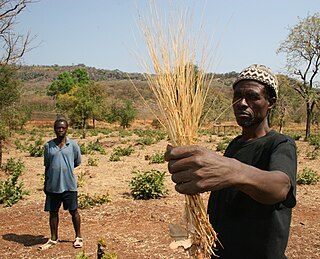
Fonio, also sometimes called findi or acha, is the term for two cultivated grasses in the genus Digitaria that are notable crops in parts of West Africa. They are millets with small grains.

Paspalum is a genus of plants in the grass family.

Digitaria is a genus of plants in the grass family native to tropical and warm temperate regions but can occur in tropical, subtropical, and cooler temperate regions as well. Common names include crabgrass, finger-grass, and fonio. They are slender monocotyledonous annual and perennial lawn, pasture, and forage plants; some are often considered lawn pests. Digitus is the Latin word for "finger", and they are distinguished by the long, finger-like inflorescences they produce.

Digitaria exilis, referred to as findi or fundi in areas of Africa, such as The Gambia, with English common names white fonio, fonio millet, and hungry rice or acha rice, is a grass species. It is the most important of a diverse group of wild and domesticated Digitaria species known as fonio that are harvested in the savannas of West Africa. The grains are very small. It has potential to improve nutrition, boost food security, foster rural development and support sustainable use of the land. Despite its valuable characteristics and widespread cultivation, fonio has generally received limited research and development attention, which is also why the species is sometimes referred to as an underutilized crop.

Eleusine indica, the Indian goosegrass, yard-grass, goosegrass, wiregrass, or crowfootgrass, is a species of grass in the family Poaceae. It is a small annual grass distributed throughout the warmer areas of the world to about 50 degrees latitude. It is an invasive species in some areas.

Paspalum scrobiculatum, commonly called Kodo millet or Koda millet, is an annual grain that is grown primarily in Nepal and also in India, Philippines, Indonesia, Vietnam, Thailand, and in West Africa from where it originated. It is grown as a minor crop in most of these areas, with the exception of the Deccan plateau in India where it is grown as a major food source. It is a very hardy crop that is drought tolerant and can survive on marginal soils where other crops may not survive, and can supply 450–900 kg of grain per hectare. Kodo millet has large potential to provide nourishing food to subsistence farmers in Africa and elsewhere.
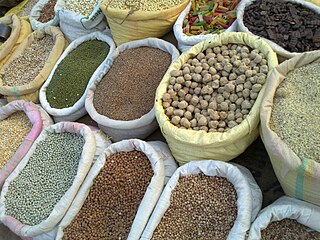
A grain is a small, hard, dry fruit (caryopsis) – with or without an attached hull layer – harvested for human or animal consumption. A grain crop is a grain-producing plant. The two main types of commercial grain crops are cereals and legumes.
Digitaria californica is a species of grass known by the common name Arizona cottontop. It is native to the Americas, where it can be found in the southwestern United States, Mexico, Central America, and South America.
Digitaria pauciflora is a species of grass known by the common names twospike crabgrass, Florida pineland crabgrass, Everglades grass, few-flowered fingergrass, and particular grass. It is endemic to Florida in the United States, where it is found only in the Everglades.
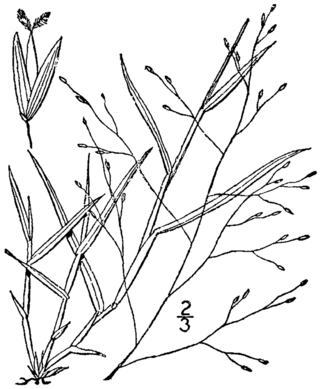
Digitaria cognata is a species of grass known by the common names fall witchgrass, Carolina crabgrass, and mountain hairgrass.
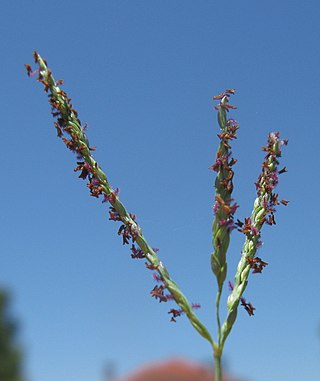
Digitaria didactyla is a species of grass known by the common names blue couch, Queensland blue couch, blue serangoon grass, green serangoon grass, blue stargrass, and petit gazon. It is native to Mauritius, Réunion, parts of mainland Africa, and Madagascar. It has been introduced widely outside its native range, mainly for use as a pasture and turf grass. It has naturalized in some regions.
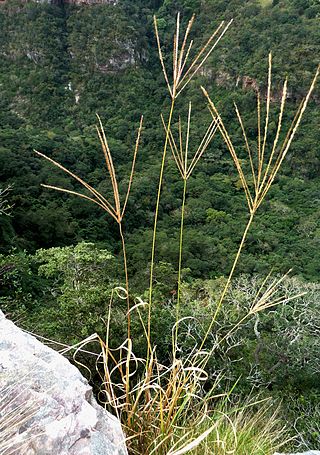
Digitaria eriantha, commonly known as digitgrass or Pangola-grass, is a grass grown in tropical and subtropical climates. It grows relatively well in various soils, but grows especially well in moist soils. It is tolerant to droughts, water lodging, suppresses weeds and grows relatively quickly after grazing. This grass demonstrates great potential for farmers in Africa in subtropical and tropical climates, mostly for livestock feed.

Digitaria ciliaris is a species of grass known by the common names southern crabgrass, tropical finger-grass, tropical crabgrass or summer grass.

Digitaria compacta is a grass species native to India and Indochina. It is cultivated in the Khasi Hills of northeast India, used as a glutinous flour for making bread or porridge, and known as raishan.
Digitaria iburua, commonly known as iburu, is a grass species native to west and west-central tropical Africa, which is cultivated as a grain crop known as black fonio.

Piptatherum holciforme is a species of perennial cereal grass known by the common names rice grass, hairy ricegrass, and hairy millet grass, endemic to Eurasia, especially the Mediterranean basin. The seed of the plant is a type of grain millet that can be ground into meal and prepared as a porridge.
Brachiaria deflexa is an annual millet grass belonging to the grass family (Poaceae). It is native to many regions such as Africa, India, and Pakistan in both tropical and subtropical regions. It has been used as a supplemental food source among other cereal crops.


















